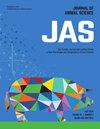生物记录仪和mirna是测量羔羊在运输过程中生理变化的创新工具
IF 2.9
2区 农林科学
Q1 AGRICULTURE, DAIRY & ANIMAL SCIENCE
引用次数: 0
摘要
对于牲畜来说,运输可能涉及几个潜在的压力因素,包括人类操作、饲养密度、空气温度、噪音、振动和装卸程序。动物对这些刺激的感知和适应能力还没有完全了解,这使得进行福利评估变得困难。本研究旨在通过生理和分子标记的变化来检测羔羊在运输过程中的应激时刻。从记录生理变量的生物记录仪获得的数据以及对皮质醇和循环microrna (c- mirna)等分子生物标志物的评估确定了运输中最紧张的时刻,这可以成为评估和改善牲畜运输条件的有价值的工具。研究人员给阿拉贡沙羔羊植入生物记录仪,记录其皮下体温(BT)和心率(HR)。抽取血浆和唾液进行分子分析;具体来说,唾液中的皮质醇浓度,血浆中的肌酸激酶(CK)和乳酸脱氢酶(LDH),血浆和唾液中的c- mirna表达谱。羔羊被卸下后,生物记录仪立即记录了一个显著的(P <;0.05) HR升高,BT下降,唾液皮质醇浓度显著升高(P <;0.05),表明卸料是羔羊的主要应激点之一。在测试的17个mirna中,有4个在表达上有显著差异(P <;0.05)。MiR-23a和-27a均在血浆和唾液中表达,而miR-17和-24在卸载后的唾液中表达最多。最后,血浆中miR-23a、-24和27a的表达显著(P <;0.05)与LDH呈显著正相关,LDH浓度与CK显著升高(P <;0.01)。该研究确定了羔羊在运输过程中和运输后的适应反应时间,这反映了绵羊血浆和唾液mirna在运输诱导应激过程中的动态特性,使它们有可能成为动物福利评估的生物标志物。本文章由计算机程序翻译,如有差异,请以英文原文为准。
Bio-loggers and miRNAs are innovative tools for measuring physiological changes in lambs during transport
For livestock, transport can involve several potential stressors including human handling, stocking density, air temperature, noise, vibration, and loading/unloading procedures. The animal’s perception of and its ability to adapt to those stimuli are not fully understood, which makes it difficult to carry out welfare assessments. This study aimed to detect stressful moments in lambs during transport through changes in physiological and molecular markers. Data obtained from bio-loggers that record physiological variables and an evaluation of molecular biomarkers such as cortisol and circulating microRNAs (c-miRNAs) identified the most stressful moments of transport, which can be a valuable tool for evaluating and improving transport conditions for livestock. Rasa Aragonesa lambs were implanted with bio-loggers that record subcutaneous body temperature (BT) and heart rate (HR). Plasma and saliva were sampled for molecular analyses; specifically, saliva for cortisol concentrations, plasma for creatine kinase (CK), and lactate dehydrogenase (LDH), plasma and saliva for c-miRNAs expression profiles. Immediately after the lambs were unloaded, the bio-loggers registered a significant (P < 0.05) spike in HR and a drop in BT, and salivary cortisol concentrations increased significantly (P < 0.05), which indicated unloading as one of the main stressful points for the lambs. Out of the 17 miRNAs tested, 4 showed a significant difference in expression (P < 0.05). MiR-23a and -27a were both expressed in plasma and saliva, while miR-17 and -24 were most expressed in saliva after unloading. Finally, the expression of plasmatic miR-23a, -24, and 27a were significantly (P < 0.05) positively correlated with the LDH whose concentrations together with those of CK are significantly increased (P < 0.01) after unloading. The study identified the timing of a lamb's adaptation response during and after transport, which reflected the dynamic nature of ovine plasma and salivary miRNAs during transport-induced stress, giving them the potential to be biomarkers that can be useful in animal welfare assessments.
求助全文
通过发布文献求助,成功后即可免费获取论文全文。
去求助
来源期刊

Journal of animal science
农林科学-奶制品与动物科学
CiteScore
4.80
自引率
12.10%
发文量
1589
审稿时长
3 months
期刊介绍:
The Journal of Animal Science (JAS) is the premier journal for animal science and serves as the leading source of new knowledge and perspective in this area. JAS publishes more than 500 fully reviewed research articles, invited reviews, technical notes, and letters to the editor each year.
Articles published in JAS encompass a broad range of research topics in animal production and fundamental aspects of genetics, nutrition, physiology, and preparation and utilization of animal products. Articles typically report research with beef cattle, companion animals, goats, horses, pigs, and sheep; however, studies involving other farm animals, aquatic and wildlife species, and laboratory animal species that address fundamental questions related to livestock and companion animal biology will be considered for publication.
 求助内容:
求助内容: 应助结果提醒方式:
应助结果提醒方式:


